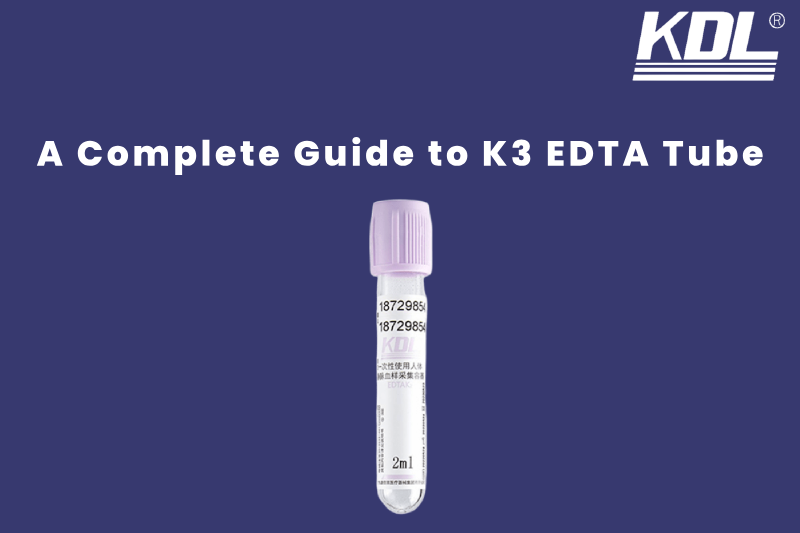
When doctors or labs need to test blood, the first step is to collect it in the right kind of tube. You may have noticed that blood collection tubes come in different colors. Each color is not just for looks—it shows the type of chemical inside the tube. These chemicals help protect the blood so that accurate tests can be done. One of the most common and important tubes is the K3 EDTA tube, which usually has a lavender or purple cap.
This tube contains a chemical called EDTA (Ethylenediaminetetraacetic Acid) in a tripotassium (K3) form. It helps stop blood from clotting so it can be tested later.
In this blog, we’ll explain in simple terms:
- What a K3 EDTA tube is
- What it’s used for
- Why it’s important in labs
- The benefits and limitations
- The difference between K2 EDTA and K3 EDTA tubes
By the end, you’ll understand why these small purple-top tubes play such a big role in medicine.
What Is a K3 EDTA Tube?
A K3 EDTA tube is a special blood collection tube used in hospitals, clinics, and laboratories.
- The letters EDTA stand for Ethylenediaminetetraacetic Acid.
- The K3 part means that three potassium ions are attached to it.
- EDTA works by binding with calcium in the blood. Since calcium is needed for clotting, when it is blocked, the blood cannot clot inside the tube.
That’s why K3 EDTA tubes are called anticoagulant tubes. They keep the blood liquid, making it easy to test under a microscope or with machines.
These tubes usually have a lavender or purple top. They come in different sizes, such as 2 ml, 3 ml, 5 ml, or 6 ml, depending on how much blood is needed for the test.
Uses of K3 EDTA Tubes
1. Hematology Testing
Hematology is the study of blood and its cells. For most hematology tests, blood must not clot. That’s why EDTA tubes are the standard choice.
Some common tests include:
- Complete Blood Count (CBC): Measures red cells, white cells, hemoglobin, and platelets.
- Blood Smears: A drop of blood is spread on a slide to look at the shape of cells.
- ESR (Erythrocyte Sedimentation Rate): Checks inflammation in the body.
- Reticulocyte Count: Measures young red blood cells.
Without K3 EDTA, these tests would be almost impossible, since clotted blood cannot be studied properly.
2. Blood Banking
Blood banks also use K3 EDTA tubes for:
- Blood typing (ABO and Rh factor)
- Cross-matching for transfusions
- Antibody screening
Because EDTA prevents clotting without changing blood cell surfaces, it makes sure blood typing is accurate. This is critical for safe blood transfusions.
3. DNA and Molecular Testing
In some cases, K3 EDTA tubes are used for DNA, RNA, and molecular studies. Since EDTA protects cells from breaking down too quickly, genetic material stays stable for longer. However, some labs prefer K2 EDTA tubes for these sensitive tests because they cause less dilution.
Benefits of K3 EDTA Tubes
Prevents Clotting Quickly
One of the best things about K3 EDTA tubes is that they may stop blood from clotting nearly right away. If blood is obtained without an anticoagulant, it starts to clot within minutes, which makes the sample unsuitable for most testing. Calcium ions, which are necessary for forming clots, are held together by the EDTA in K3 tubes. By stopping calcium, blood remains in liquid state and doesn’t clot.
This rapid response is very critical in crowded hospital laboratories, where delays may damage samples and make patients have to have blood drawn again.
Keeps Blood Cells in Good Shape
K3 EDTA is great in keeping blood cells’ size, shape, and structure the same. Red blood cells, white blood cells, and platelets remain whole, which makes it possible for lab equipment and microscopes to get accurate measurements. Results of tests might be wrong if cells alter form or break apart.
A CBC (Complete Blood Count) is one example of a test that needs correct cell counts and measurements. Doctors could get the wrong idea about anemia, infections, or clotting issues if they don’t have EDTA.
Provides Stable Results
Blood samples are stable for hours after collection in K3 EDTA tubes, as long as they are maintained correctly. Factors like:
- Count of platelets
- Mean Corpuscular Volume (MCV)
- Red Cell Distribution Width (RDW)
- Mean Platelet Volume (MPV)
This offers laboratories adequate time to process samples even if there is a slight delay.
For example, a sample taken in the morning may still provide reliable findings later in the day, which is useful for clinics that see a lot of patients.
Reduces Platelet Clumping
Platelet clumping is a typical issue when testing blood. Automated devices could count platelets as less than they actually are when they stick together, which might make platelet counts seem lower than they are. This may scare physicians and make them undertake more tests that aren’t needed. K3 EDTA keeps platelets separate, which stops them from clumping together. This makes sure that the count is accurate and shows how many platelets are in the blood.
This is particularly crucial for detecting illnesses like thrombocytopenia (low platelet count), when being accurate may directly impact the choices made about therapy.
Affordable and Easy to Find
Another big benefit of K3 EDTA tubes is that they are affordable and easy to get. They are less expensive to make and buy than specialized tubes, which helps labs keep their prices down. K3 EDTA tubes are the most used option for most hematological and blood bank tests across the globe since they are cheap.
K3 EDTA tubes are nearly always accessible, whether it’s a little clinic in the country or a big hospital lab. This makes them a reliable choice for regular testing.
Differences Between K2 and K3 EDTA Tubes
Many people wonder: What’s the difference between K2 and K3 EDTA tubes? Both are lavender-top tubes, but they are not exactly the same.
| Feature | K2 EDTA Tube | K3 EDTA Tube |
| Form | Dry spray coating | Liquid solution |
| Sample Effect | No dilution | Slight dilution possible |
| Best For | DNA, HbA1c, trace metals, sensitive tests | CBC, blood smears, blood banking |
| Cap Color | Lavender (sometimes pink) | Lavender or purple (sometimes pink) |
| Common Use | Specialized tests | Routine hematology |
In short:
- K3 EDTA is great for routine hematology and blood bank work.
- K2 EDTA is better for sensitive or specialized testing.
Limitations of K3 EDTA Tubes
Even though K3 EDTA tubes are widely used, they are not right for every test.
- They are not good for chemistry tests like calcium, potassium, or magnesium, since EDTA binds these ions.
- They are not suitable for coagulation studies like PT, aPTT, or D-dimer, because EDTA blocks the clotting process completely.
- They may slightly dilute blood, which can cause small differences in some results compared to K2 EDTA.
That’s why it’s important for labs to choose the correct EDTA tube for the correct test.
How to Choose the Right Tube for Your Lab
Choosing between K2 EDTA and K3 EDTA tubes might seem simple, but the right decision can make a big difference in lab results. Here are the factor to consider:
Type of Tests Performed
Think about what your lab does most often. If you run routine hematology tests like CBCs, ESR, or blood smears, K3 EDTA tubes are a reliable, affordable option. If you do more specialized tests such as HbA1c, DNA/RNA work, or trace metal analysis, K2 EDTA is usually the better choice because it avoids the slight dilution effect of liquid K3 EDTA.
Quality Standards
Not all tubes are the same. Check that the tubes you buy follow ISO and CLSI rules. These things are important for patient safety because they make sure that things are always the same, correct, and reliable.
Trusted Manufacturers
Stick with well-known brands like KDL, BD, Greiner Bio-One (Vacuette), or Terumo. Reputable manufacturers have better quality control, fewer broken tubes, and more consistent performance than unknown or generic suppliers.
Proper Storage and Handling
If you don’t handle it right, even the best tube won’t work. Always: After collecting, gently turn the tubes upside down (never shake). Keep them at the right temperature. Before using, check the expiration date. Proper storage and handling keep blood samples safe and stop mistakes.
Conclusion
K3 EDTA tubes are one of the most important tools in modern laboratories. Their ability to stop blood from clotting and keep cells in good condition makes them perfect for CBCs, blood smears, ESR, and blood banking.
They are affordable, widely available, and easy to use. However, they also have limits. They are not suitable for chemistry or coagulation tests and may slightly dilute samples.
The choice between K2 vs K3 EDTA depends on the needs of the lab. K3 is best for routine hematology, while K2 is better for specialized testing.
By understanding the uses, benefits, and differences, labs can make the right decision, leading to better accuracy, safer blood transfusions, and improved patient care.
 +86-791-8686-1216
+86-791-8686-1216 

